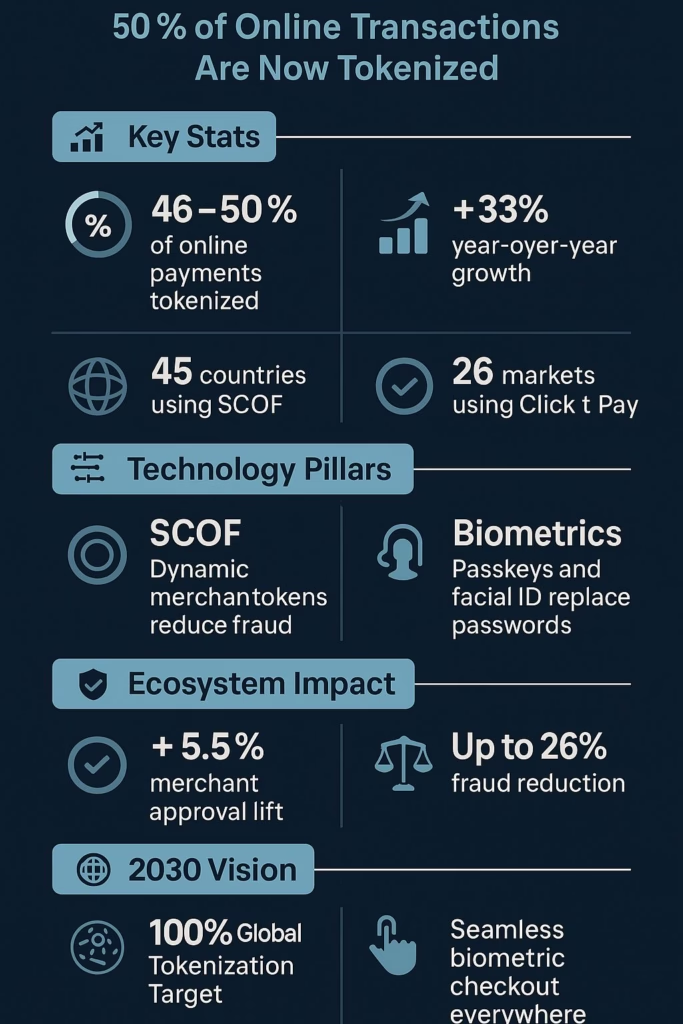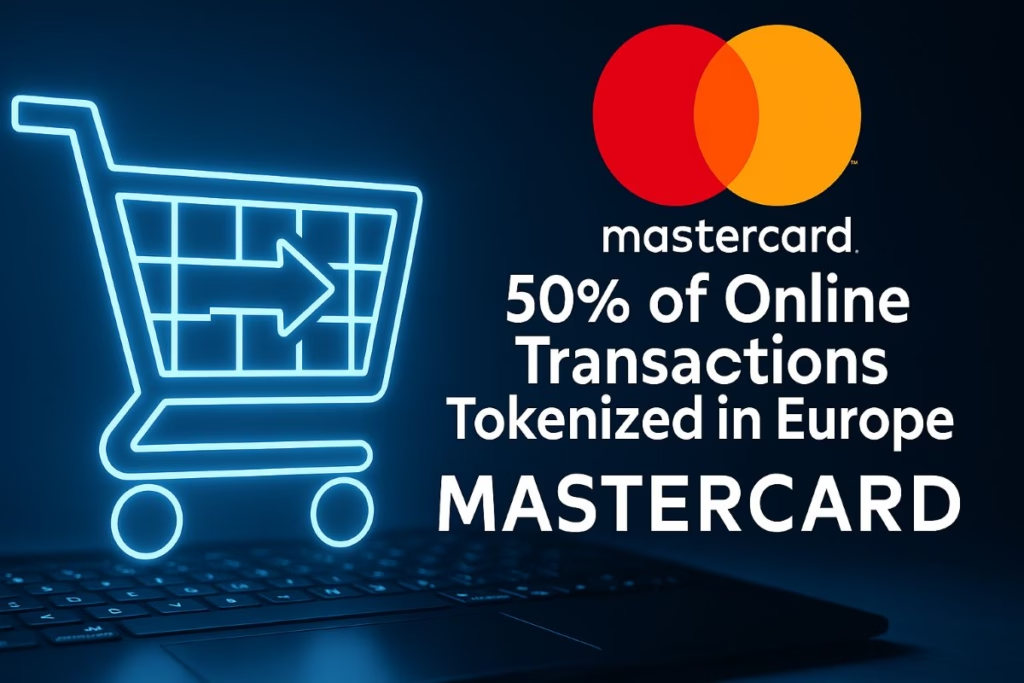Mastercard has reached a historic milestone—nearly half of all online transactions in Europe are now tokenized. With Secure Card on File, Click to Pay, and biometric passkeys, the company is setting a new standard for secure, seamless e-commerce experiences across 45+ countries.
“Tokenization and biometric authentication aren’t the future of payments—they’re the present standard for secure, frictionless commerce.”
— Jorn Lambert, Chief Digital Officer, Mastercard
🛒 Mastercard’s Digital Checkout Revolution
Mastercard has achieved a pivotal step in digital payments. Around 50% of its European online transactions are now tokenized, reflecting a massive stride toward its goal of 100% e-commerce tokenization by 2030.
This milestone signifies not just progress, but a fundamental shift in how security and convenience coexist in online payments.
🖥️ Tokenized Transactions by the Numbers
- 46–50% of online transactions in Europe are now tokenized.
- That’s a 33% increase year-over-year, according to Mastercard’s European digital division.
- Secure Card on File (SCOF) operates in 45 countries; Click to Pay now spans 26.
Tokenization replaces sensitive card data with merchant-specific dynamic tokens, safeguarding consumers and boosting approval rates by up to 5.5%.
🛡️ Inside the Technology: SCOF, Click to Pay & Biometrics
Secure Card on File (SCOF):
Replaces static card details with unique tokens, isolating sensitive data and drastically reducing fraud.
Click to Pay:
A one-click, account-free checkout solution used across 26 markets. Enrollment has more than doubled in the past year, simplifying checkout and increasing repeat purchases.
Biometric Passkeys:
The latest layer integrates fingerprint and facial authentication, removing the need for passwords while complying with PSD2’s Strong Customer Authentication (SCA).
Together, these technologies power a passwordless, secure, and effortless checkout journey.
🌍 Why It Matters
Fraud Reduction
By removing card numbers from merchant databases, tokenization lowers the risk of breaches and identity theft.
User Experience
No passwords, no re-typing—just click, verify, and pay.
Merchant Benefits
Merchants see higher approval rates, reduced chargebacks, and smoother conversions—some as high as 5.5% increases.
Regulatory Alignment
Tokenization supports EU frameworks such as PSD2 and SCA, ensuring compliance and interoperability across the payments ecosystem.

⚙️ The Road to 100% Transactions Tokenized
Mastercard’s roadmap to total tokenization includes:
- Expanding SCOF and Click to Pay to more global markets.
- Auto-enrolling banks and processors to accelerate adoption.
- Embedding biometric passkeys in browsers and mobile apps.
- Phasing out manual card entry entirely by 2030.
By then, entering a card number online could be as outdated as swiping a magnetic stripe.
📊 The Ripple Effect
This shift is reshaping every layer of the payment chain:
- Consumers enjoy faster, safer, and more intuitive experiences.
- Merchants report fewer fraud losses and abandoned carts.
- Fintechs and PSPs (Checkout.com, Santander, N26) are building native token and biometric solutions.
- Networks like Visa, Amex, and Discover are aligning under EMVCo standards, ensuring cross-network compatibility.
🔮 What’s Next?
- Global Expansion: Tokenization is rolling out across North America, APAC, and Latin America.
- Deeper Biometric Integration: Expect passkeys and face recognition embedded in everyday payments.
- Full Data Privacy Framework: Mastercard is designing multi-network interoperability for tokenized identity and commerce.
By 2030, Mastercard aims for a fully tokenized e-commerce landscape—one where card numbers never touch the open web again.
✅ Conclusion: The Next Era of Trust in Payments
Mastercard’s 50% milestone marks a turning point. Tokenization isn’t just about fraud prevention—it’s a reengineering of trust in digital commerce. With biometric authentication and global regulatory alignment, Mastercard is leading the charge toward a passwordless, tokenized world where every transaction is instant, invisible, and secure.
❓ FAQs: Mastercard Tokenization & Digital Payments
Tokenization replaces a card’s primary account number (PAN) with a unique digital “token.” This ensures merchants never store real card data—boosting payment security and compliance.
As of 2025, nearly 50% of online transactions in Europe are tokenized through Mastercard’s Secure Card on File (SCOF) and Click to Pay systems.
SCOF replaces card credentials with dynamic merchant-specific tokens, reducing fraud and increasing approval rates across 45 European countries.
Click to Pay simplifies payments with one-click authentication—no passwords or manual card entry. It now operates in 26 European markets and has doubled enrollments year over year.
Merchants see up to 5.5% higher approval rates and fewer chargebacks. Tokenization streamlines compliance under the EU’s PSD2 regulation while enhancing trust.
Mastercard’s biometric passkeys (face or fingerprint) eliminate passwords, creating secure, frictionless experiences that meet Strong Customer Authentication (SCA) standards.
To reach 100% tokenization of all online transactions globally, phasing out manual card entry and replacing it with secure, one-click digital payments.

